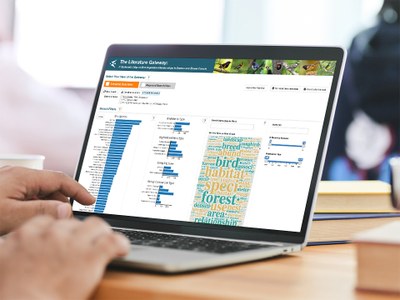Background
Background
This literature gateway was inspired by a desire to better understand how broad changes in forest management practices might affect forest vegetation, and subsequently, populations of different bird species at regional scales. The Natural Resources Conservation Service funded a project to simulate long term, dynamic changes in forest landscape conditions and evaluate how these changes might effect bird populations. An initial step in this process is compiling and synthesizing the best available science on bird species-vegetation relationships. To do this, we chose to follow internationally-recognized guidance on the conduct of systematic reviews to compile all available literature on this topic in a systematic map, which we present here as an interactive data visualization.
The Web-based Literature Gateway

This interactive data visualization was created to facilitate the exploration and discovery of the extensive literature that is available to address breeding bird species-vegetation relationships in eastern and boreal forests of North America. It is intended to be used by (and useful to) students, research scientists, ecologists, natural resource managers, policy makers, and any stakeholder interested in how forest management may affect bird populations via management-related changes to forest vegetation composition and structure. By following systematic review guidance and protocols, we have been able to compile a comprehensive set of documents that present quantitative information on at least one bird metric (e.g., abundance, occurrence, habitat selection) AND one vegetation metric (e.g., species composition, structure, or specific resource attributes) for 144 different forest bird species that occur in the eastern and boreal forests of North America.
This resource reflects a systematic search of >60 different sources, including subscription-based academic search engines, government agency document repositories, organizational websites, publisher websites, and web-based search engines. It allows users to search for references using article-specific metadata that was extracted by subject experts and a curated list of keywords that have been extracted via text analysis. Given the thoroughness of the literature search, the protocol-based extraction of article metadata, and the discipline-specific list of keywords provided as search elements, the gateway should provide an excellent resource for finding literature on a large number of management-relevant topics. It will also provide a way for peer reviewers, agency biologists, and policy makers to evaluate whether the recommendations they receive from research scientists reflect the full body of available evidence. We hope that these functions help to ensure that the best available science, reflecting decades of scientific effort, is being put to its full use in the study of forest wildlife habitat relationships and decision-making processes related to forest resource management.
Acknowledgements:
The Literature Gateway data visualization tool was inspired by, and is dedicated to, several remarkable groups.
First, we acknowledge that without the herculean efforts of library scientists and bibliographic database managers over the past half century, it would simply be impossible to access such a large body of literature, on any topic, much less one as specific as bird-vegetation relationships.As the volume of information produced by scientists increases exponentially, we encourage all users of this tool to recognize the importance and value of maintaining and expanding the data storage, extraction, and exploration infrastructures that support the continued growth of science as an enterprise that continues to build on its own achievements. Given the challenges of searching for, compiling, and evaluating literature for this broad topic systematic map, we will never take this infrastructure for granted again!
Second, we recognize that without insights from key figures in the field of information science and data visualization, particularly Edward Tufte, Ben Schneiderman, Steven Few, and Miguel Cairo, we would have never stumbled upon the core design principles that support effective interactive data visualizations. We hope that they stumble upon this tool and criticize us soundly!
Third, we are grateful to the many software engineers and developers who have created sophisticated tools, like JMP (which we used extensively for text analyses) and R shiny (which was used to create this web-based product) that allow for the exploration of rich, and highly dimensional data sets, like systematic maps.
Fourth, we are grateful to the many scientists associated with the Collaboration for Environmental Evidence, who have put forth, and regularly updated, robust standards for the creation and documentation of information synthesis via systematic literature review. In the fight against bias, which becomes more important every day, these are the giants whose shoulders we stand on.
Finally, we thank the USDA’s Natural Resources Conservation Service’s Working Lands for Wildlife Program for their interest in supporting a project with the challenging objective of making such a large body of scientific information available to a broad user community of forest managers, policy makers, scientists, journal editors, conservation planners, and other stakeholder groups that have a vested interest in making sure that the best available science is consulted to inform decisions in the intersection between species conservation and natural resource management.





















